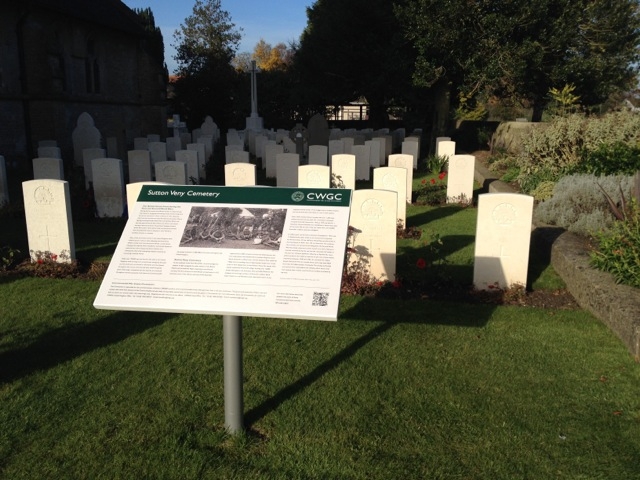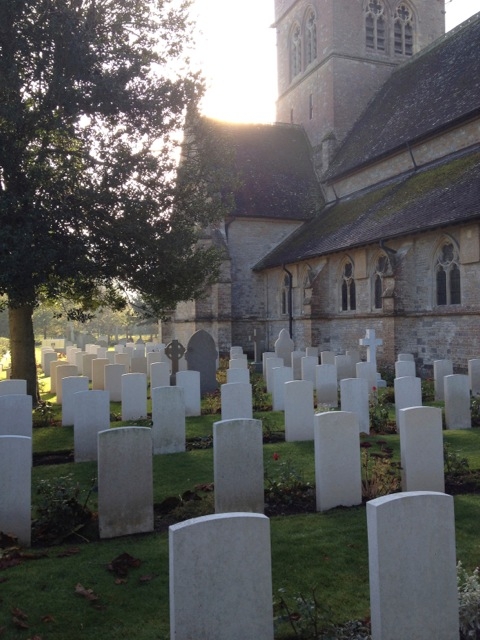Inspired by a call to remember the Commonwealth dead of the First World War commemorated in the UK, Centenary News’ Peter Alhadeff visited a cemetery in Wiltshire.
It’s a scene familiar to anyone who’s toured the battlefields of the First World War in Flanders and France. Neat rows of white headstones stretch across an immaculate cemetery, set against the tranquil background of gently rolling countryside. But this is a churchyard in the county of Wiltshire in southern England, one of the thousands of locations in the UK where the dead of the First World War are commemorated by the Commonwealth War Graves Commission.
The cemetery, in the grounds of the parish church of St. John the Evangelist in Sutton Veny, is the kind of site the Commission is urging the people of Britain not to forget as the Centenary year of 2014 dawns.
In November 2013, the CWGC launched a campaign to raise awareness of its work within the UK. More than 300,000 Commonwealth servicemen and women who died in the two world wars are commemorated here. Their graves and memorials are to be found at almost 13,000 locations.
‘A special place’
Sutton Veny is one of them, and in the words of the CWGC, it is a “very special place.” Most of those buried in St. John’s churchyard are Australians, and the links with Australia are still keenly fostered.
Peter Francis, the Commission’s media and marketing manager, told Centenary News: “The war graves in Sutton Veny are a very special reminder of the sacrifices made during the Great War by Commonwealth servicemen and women.
“The site is typical of the thousands of locations here in the United Kingdom where the Commonwealth War Graves Commission looks after war graves. It is our intention to make these places better known over the Centenary, to encourage people to visit, to learn and to remember.”

Sutton Veny churchyard, showing the information panel for visitors recently installed by the Commonwealth War Graves Commission
A military plot was first provided at St. John’s in 1915, with 15 British burials.
Sutton Veny’s position close to the garrison town of Warminster and the training grounds of Salisbury Plain made the village and surrounding area an ideal place to base soldiers before their deployment to the Western Front.
Ten camps were established, housing more than 10,000 troops belonging to the Australian 26th and 34th Divisions, who’d been sent to fight alongside British forces.
From 1916, a hutted military hospital with over 1,200 beds treated casualties returning from the front. The No.1 Australian General Hospital was established at Sutton Veny after the Armistice in 1918.
Flu pandemic
Of the 168 First World War burials in the churchyard, 143 are Australians. Two thirds of those remembered here died of illness or wounds suffered during the First World War. But the remainder fell victim to the flu pandemic which killed millions of people worldwide between 1918 and 1920.
There’s no doubt that the Centenary will focus much public attention on the Commonwealth War Graves Commission, not least its work at the best known cemeteries in France and Belgium. But the CWGC is keen to ensure that its many sites in Britain are not overlooked either.

St. John’s Church
In Sutton Veny at least, the village’s links with the events of almost a century ago are far from forgotten. Every year, a memorial service is held at St. John’s Church on the Sunday closest to Anzac Day, 25th April.
The local MP is Dr. Andrew Murrison, a former medical officer in the Royal Navy whose duties now include serving as the British Prime Minister’s Special Representative for the Great War Centenary Commemorations. He explained how the history of the Commonwealth cemetery is actively passed on from generation to generation:
“Every year the children from the adjacent primary school, which my children used to attend, lay posies at the graves of service personnel,” he told Centenary News.
“ANZAC Day at Sutton Veny is a significant event with high level representation from the Australian and New Zealand High Commissions. So ANZAC Day and the Great War are important parts of the local scene, connections that I expect to see enhanced further during the upcoming centenary.”
Sutton Veny lies just a few miles off one of Britain’s busiest routes between London and the southwest of England. Despite travelling across Salisbury Plain for many years, I was unaware of the significance of St John’s churchyard until the Centenary approached. Perhaps more will now pause here to reflect on the lasting ties forged between this village and the people of Australia during the First World War.
Source: Commonweath War Graves Commission
© Centenary Digital Ltd & Author
